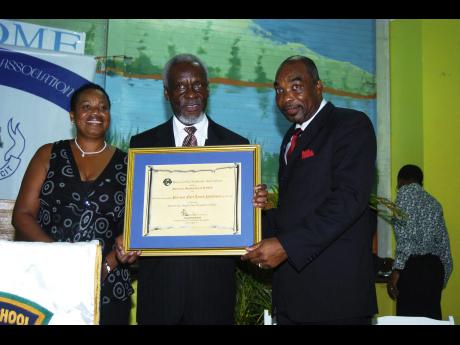My Political Journey: Jamaica’s Sixth Prime Minister Pt. 1 | A proud 'Hanoverian'
P.J. Patterson, ON, OCC, PC, QC, was Jamaica's sixth and longest-serving prime minister from 1992 to 2006. His book, 'My Political Journey: Jamaica's Sixth Prime Minister' will be launched on December 12. The Gleaner will be publishing excerpts every day until the launch. This is Part One.
I was born on April 10, 1935, just three years shy of the one hundredth anniversary of the abolition of slavery.
My mother, Ina Miriamne James, born on June 15, 1898 in Dias, Hanover, was one of two children. Her elder brother, Richard, succumbed, before the age of puberty, to a severe case of crab poisoning.
She attended the Mount Moriah Baptist School in Hanover. She was an excellent student and went on to become a teacher herself. At the age of 20, she joined the staff of the Mount Peto Elementary School, where her aunt's husband, Daniel Henry, served as principal.
It was while teaching at the Churchill Primary School, near Green Island in Hanover, that 'Miss I', as my mother was affectionately called, met my father, Henry Patterson. He had served as an overseer on the Eaton Estate, referred to by the surrounding communities as Santoy, owned by the Sanftleben family.
Some would call him 'Busha', but he was also known as 'Mas' Hen', which he greatly preferred. He built a house, May Park, from which we often watched cricket being played on the playing field across the road. He also owned several parcels of land that had been sold by the colonial government for land settlement in the nearby village of Logwood. One of these was the source of water that the National Water Agency bought in 1954 to supply the needs of tourism development in Negril. It became known as Patterson Hole.
During school holidays, I enjoyed many visits to my father. I helped to milk the cows; tend to the dogs and the chickens in the yard; I learned how to ride a horse and a bicycle; I particularly enjoyed travelling in a buggy to church.
Trained farrier
Henry Patterson loved horse racing and went to races at the Willie Reid Race Course in Cave Valley. As a trained farrier, Mas' Hen offered his services freely to anyone who had an injured animal and sent for him. He had a stallion that bred the horses within his own stable.
He was generally up at the crack of dawn and rode out every day to tend to his farms, where he grew sugar cane, rice and bananas and saw to his cattle and pigs. Although active and otherwise healthy, he limped with his right foot, which was ascribed to an overdose of quinine to treat typhoid.
He was regarded as a benefactor to the community, especially the poor. He was kind, considerate and jocular. He would send milk for children and old people who could not afford it. He enjoyed good music, which was played on the HMV gramophone from his fine collection of vinyl records. But on Sundays, only sacred music was permitted.
He was a deacon in the Anglican Church and sat in the family pew every Sunday. He was not given to smoking or drinking alcohol. My father had nine children - Florence, John, Reginald, Daisy, Fred, Vida, Percy, Merle and Monica.
On my earliest visit to Nigeria as a university student, I listened with fascination to stories of the bitter disputes which had arisen in several tribes as to the rights of succession when a vacancy occurred in the chieftaincy. Among the cardinal rules was a requirement for the "navel string" - umbilical cord - to have been buried within the tribal borders. It was not where you first peeped at the light, but where your navel string was buried that determined your ancestral home.
Christening
Mine was buried under the otaheite apple tree in the Mount Pleasant yard of the Dawes family, at Kendal in the parish of Hanover, from where I come. In every respect and by any measure, I am a true Hanoverian. I was taken by my godparents, Cyprian and Greta Dawes, and christened at the St Luke's Anglican Church nearby.
I got a good start in the rudiments of learning at an early age. This was hardly surprising, coming from a family of teachers. I was the sole pupil of my elderly cousin Rosa Carter, who had been well trained by my grandmother, Eliza James, and was widely regarded by the community as one of the finest infant school teachers around. My Sunday school teacher was Mrs Ursula Dilworth, at the Mount Moriah Baptist Church. She also served as the organist.
Whenever adults were engaged in 'big people' conversation and did not want me to understand, they would use aphorisms or engage in parables. At other times, they would resort to spelling the key words in the sentences. This continued until the day I corrected a visitor to the house who had spelled a word incorrectly. Eventually, whenever they wanted to share anything that was secret they moved to another part of the house or sent me out to play.
In reflecting on my childhood, I realise that any successes I achieved in my academic and professional careers are unquestionably the product of the family and communities which nurtured me. Everyone in that small village of Dias was there to protect the infant 'Baby P', who lived in the house on the hill, York View, my maternal family home, and to extend a caring hand at every step of the way.

